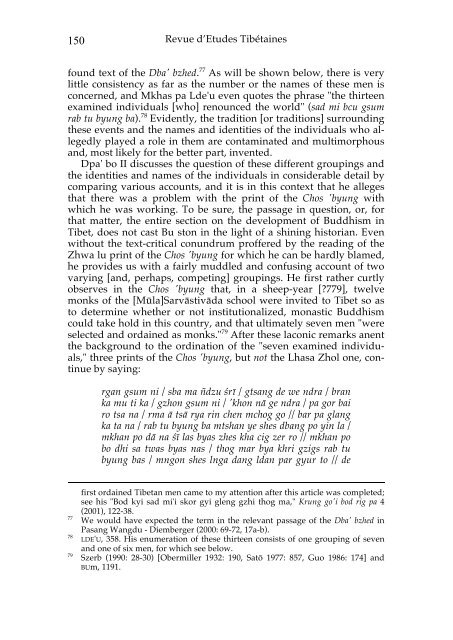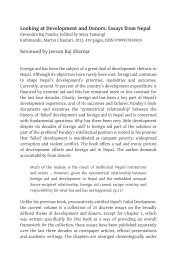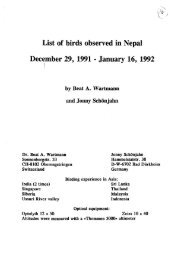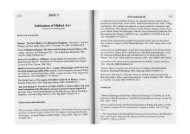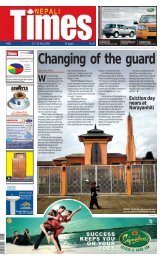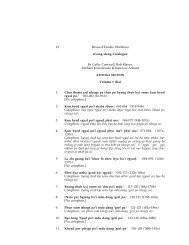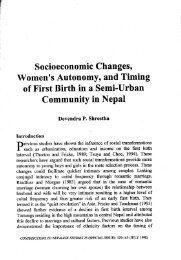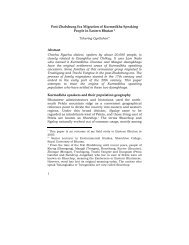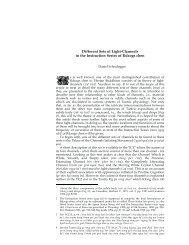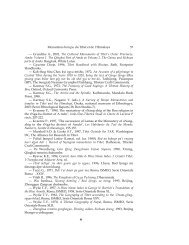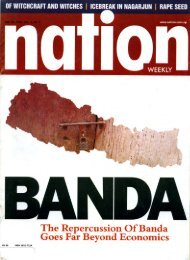Some Remarks on the Textual Transmission and Text of Bu ston
Some Remarks on the Textual Transmission and Text of Bu ston
Some Remarks on the Textual Transmission and Text of Bu ston
Create successful ePaper yourself
Turn your PDF publications into a flip-book with our unique Google optimized e-Paper software.
150<br />
Revue d’Etudes Tibétaines<br />
found text <strong>of</strong> <strong>the</strong> Dba' bzhed. 77 As will be shown below, <strong>the</strong>re is very<br />
little c<strong>on</strong>sistency as far as <strong>the</strong> number or <strong>the</strong> names <strong>of</strong> <strong>the</strong>se men is<br />
c<strong>on</strong>cerned, <strong>and</strong> Mkhas pa Lde'u even quotes <strong>the</strong> phrase "<strong>the</strong> thirteen<br />
examined individuals [who] renounced <strong>the</strong> world" (sad mi bcu gsum<br />
rab tu byung ba). 78 Evidently, <strong>the</strong> traditi<strong>on</strong> [or traditi<strong>on</strong>s] surrounding<br />
<strong>the</strong>se events <strong>and</strong> <strong>the</strong> names <strong>and</strong> identities <strong>of</strong> <strong>the</strong> individuals who allegedly<br />
played a role in <strong>the</strong>m are c<strong>on</strong>taminated <strong>and</strong> multimorphous<br />
<strong>and</strong>, most likely for <strong>the</strong> better part, invented.<br />
Dpa' bo II discusses <strong>the</strong> questi<strong>on</strong> <strong>of</strong> <strong>the</strong>se different groupings <strong>and</strong><br />
<strong>the</strong> identities <strong>and</strong> names <strong>of</strong> <strong>the</strong> individuals in c<strong>on</strong>siderable detail by<br />
comparing various accounts, <strong>and</strong> it is in this c<strong>on</strong>text that he alleges<br />
that <strong>the</strong>re was a problem with <strong>the</strong> print <strong>of</strong> <strong>the</strong> Chos 'byung with<br />
which he was working. To be sure, <strong>the</strong> passage in questi<strong>on</strong>, or, for<br />
that matter, <strong>the</strong> entire secti<strong>on</strong> <strong>on</strong> <strong>the</strong> development <strong>of</strong> <strong>Bu</strong>ddhism in<br />
Tibet, does not cast <strong>Bu</strong> st<strong>on</strong> in <strong>the</strong> light <strong>of</strong> a shining historian. Even<br />
without <strong>the</strong> text-critical c<strong>on</strong>undrum pr<strong>of</strong>fered by <strong>the</strong> reading <strong>of</strong> <strong>the</strong><br />
Zhwa lu print <strong>of</strong> <strong>the</strong> Chos 'byung for which he can be hardly blamed,<br />
he provides us with a fairly muddled <strong>and</strong> c<strong>on</strong>fusing account <strong>of</strong> two<br />
varying [<strong>and</strong>, perhaps, competing] groupings. He first ra<strong>the</strong>r curtly<br />
observes in <strong>the</strong> Chos 'byung that, in a sheep-year [?779], twelve<br />
m<strong>on</strong>ks <strong>of</strong> <strong>the</strong> [Mūla]Sarvāstivāda school were invited to Tibet so as<br />
to determine whe<strong>the</strong>r or not instituti<strong>on</strong>alized, m<strong>on</strong>astic <strong>Bu</strong>ddhism<br />
could take hold in this country, <strong>and</strong> that ultimately seven men "were<br />
selected <strong>and</strong> ordained as m<strong>on</strong>ks." 79 After <strong>the</strong>se lac<strong>on</strong>ic remarks anent<br />
<strong>the</strong> background to <strong>the</strong> ordinati<strong>on</strong> <strong>of</strong> <strong>the</strong> "seven examined individuals,"<br />
three prints <strong>of</strong> <strong>the</strong> Chos 'byung, but not <strong>the</strong> Lhasa Zhol <strong>on</strong>e, c<strong>on</strong>tinue<br />
by saying:<br />
rgan gsum ni / sba ma ñdzu śrī / gtsang de we ndra / bran<br />
ka mu ti ka / gzh<strong>on</strong> gsum ni / 'kh<strong>on</strong> nā ge ndra / pa gor bai<br />
ro tsa na / rma ā tsā rya rin chen mchog go // bar pa glang<br />
ka ta na / rab tu byung ba mtshan ye shes dbang po yin la /<br />
mkhan po dā na śī las byas zhes kha cig zer ro // mkhan po<br />
bo dhi sa twas byas nas / thog mar bya khri gzigs rab tu<br />
byung bas / mng<strong>on</strong> shes lnga dang ldan par gyur to // de<br />
77<br />
78<br />
79<br />
first ordained Tibetan men came to my attenti<strong>on</strong> after this article was completed;<br />
see his "Bod kyi sad mi'i skor gyi gleng gzhi thog ma," Krung go'i bod rig pa 4<br />
(2001), 122-38.<br />
We would have expected <strong>the</strong> term in <strong>the</strong> relevant passage <strong>of</strong> <strong>the</strong> Dba' bzhed in<br />
Pasang Wangdu - Diemberger (2000: 69-72, 17a-b).<br />
LDE'U, 358. His enumerati<strong>on</strong> <strong>of</strong> <strong>the</strong>se thirteen c<strong>on</strong>sists <strong>of</strong> <strong>on</strong>e grouping <strong>of</strong> seven<br />
<strong>and</strong> <strong>on</strong>e <strong>of</strong> six men, for which see below.<br />
Szerb (1990: 28-30) [Obermiller 1932: 190, Satō 1977: 857, Guo 1986: 174] <strong>and</strong><br />
BUm, 1191.


